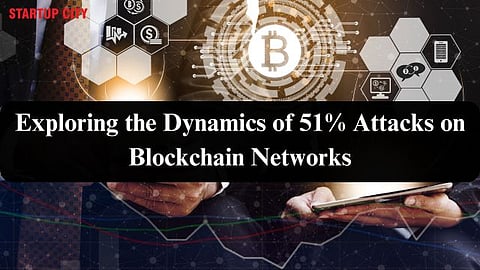

Cryptocurrency and blockchain technology have revolutionised the financial realm, presenting decentralised and secure transaction avenues. Nonetheless, akin to any technological advancement, blockchain isn't immune to vulnerabilities. Among the most formidable threats to a blockchain network is the 51% attack.
This article delves into the essence of a 51% attack, identifies those susceptible to it, and discusses the costs incurred.
A 51% attack occurs when an individual or group acquires over 50% of a blockchain network's hashing power or computational resources. This dominant control empowers attackers to manipulate the blockchain's operations in various detrimental ways. They can obstruct the confirmation of new transactions, effectively stalling payments among users.
Furthermore, they can reverse transactions that have not yet been confirmed, thereby enabling double-spending—an essential vulnerability that blockchain mechanisms like Bitcoin's proof-of-work protocol aim to avert.
Blockchains serve as distributed ledgers, meticulously recording every transaction within the cryptocurrency network. When attackers seize control, they can disrupt the customary recording of new blocks and exploit the network. Nonetheless, revising historical blocks proves exceedingly challenging, particularly in well-established blockchains like Bitcoin. Conversely, smaller networks are more susceptible to 51% attacks due to their relatively diminished computational power and security.
At its core, a blockchain functions as a decentralised ledger, housing transactions in interconnected blocks through cryptographic methods. Each block retains data from the preceding one, constructing an immutable chain of records. Agreement on transactions is achieved via a validation process involving all network participants.
During a 51% attack, the perpetrator commandeers a majority of the network's hashing power, granting them the capacity to fabricate an altered blockchain. This modified blockchain is introduced at a specific juncture, and given the attacker's majority control, the network seemingly adopts its version. Nevertheless, manipulating historical blocks proves exceedingly challenging; the farther back transactions go, the more confirmations they accumulate, rendering alterations highly impractical.
Conducting a 51% attack poses considerable challenges and costs, particularly on expansive networks. Attackers must take 51% of the network's hashing power and fabricate an alternative blockchain to introduce strategically. For instance, the WhatsMiner M63S, a prominent ASIC miner, carries a price tag exceeding $10,000 and boasts a hash rate of 406 terahashes per second (TH/s). To surpass the Bitcoin network, attackers would require thousands of such machines, rendering the attack financially unfeasible.
When Ethereum switched to proof-of-stake, a 51% attack became even pricier. Attackers would have to control 51% of the staked Ether (ETH). As of May 8, 2024, more than 32.3 million ETH were staked, meaning attackers would need over 16.5 million ETH, worth over $49 billion, to try an attack. Plus, the consensus method would probably spot and penalise attackers by cutting their staked ETH, causing them big money losses.
Apart from the expenses, when a 51% attack happens is very important. Even if attackers have 51% control, they need to bring in the changed blockchain exactly to beat the creation of new blocks by honest folks. This can work in smaller networks with fewer people and hash rates, but it's almost impossible in big networks like Bitcoin.
When a 51% attack is successful, the attackers can stop or undo transactions, causing double-spending. Double spending is like making fake money digitally, where the same cryptocurrency is used multiple times. Attackers might also carry out a Denial-of-Service (DoS) attack, stopping other miners from adding new blocks and making sure their changed chain stays permanent.
Smaller cryptocurrencies with lower hash rates face higher risks of 51% attacks. Networks protected by ASIC miners are less vulnerable compared to those accessible for mining using general-purpose GPUs, as ASICs are more efficient and speedy. Additionally, cloud mining services pose a threat by simplifying the process of renting sufficient hash power to execute an attack.
Bitcoin Gold, a minor cryptocurrency, has experienced multiple 51% attacks. Since June 2019, over 40 such attacks have targeted Bitcoin Gold, Litecoin, and other minor cryptocurrencies.
As of May 8, 2024, Bitcoin's network hash rate was 569.29 exahashes per second (EH/s), with the top three mining pools collectively controlling 72.1% of this hash rate. FoundryUSA held 175.76 EH/s (30.9%), followed by AntPool with 161.77 EH/s (28.4%), and ViaBTC with 73.11 EH/s (12.8%).
If FoundryUSA and ViaBTC collaborated, they could potentially surpass the 51% threshold of the network's hash rate. However, it's important to note that these pools have maintained stability over the years without any major issues, and any sudden malicious activity would likely result in a loss of trust from honest miners.
Executing a 51% attack on Bitcoin demands over 304 exahashes per second (EH/s) of computing power, which entails an immense cost considering that a single top-tier ASIC miner hashes at 406 terahashes per second (TH/s) and carries a price tag exceeding $10,000. This equates to requiring approximately 84,000 such units, representing a prohibitively high expense.
In conclusion, a 51% attack poses a significant danger to cryptocurrency networks, especially the smaller ones. Though more extensive networks like Bitcoin and Ethereum are safer because they have more security and people involved, the risk remains. It's unlikely that such an attack would happen on an extensive network because it's expensive and complicated. However, the possible consequences show why having decentralised and secure blockchain networks is crucial.